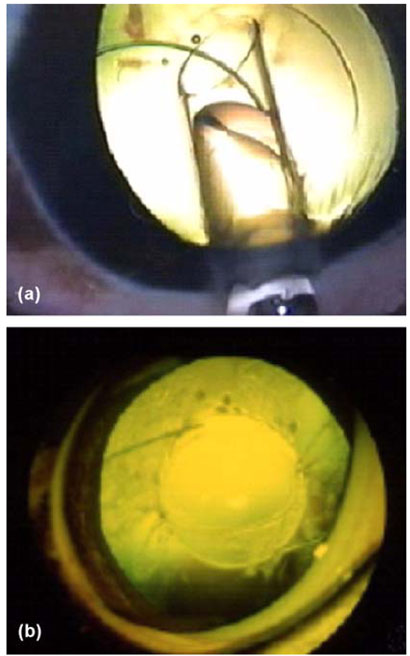J Vet Sci.
2006 Sep;7(3):281-285. 10.4142/jvs.2006.7.3.281.
Phacoemulsification and acryl foldable intraocular lens implantation in dogs: 32 cases
- Affiliations
-
- 1Department of Veterinary Ophthalmology, College of Veterinary Medicine, Seoul National University, Seoul 151-742, Korea. kmseo@snu.ac.kr
- KMID: 1089914
- DOI: http://doi.org/10.4142/jvs.2006.7.3.281
Abstract
- This study evaluated the surgical outcome and complications of phacoemulsification and the implantation of an acryl foldable intraocular lens (IOL) with a squared edge in dogs with cataracts. Thirty-two eyes from 26 dogs were examined. The mean follow up period was 75.9 days ranging from 23 to 226 days. The complications after phacoemulsification were posterior capsular opacity (PCO) around the IOL (n = 11), ocular hypertension (n = 4), focal posterior synechia (n = 4), hyphema (n = 3) and corneal ulcer (n = 2). The complications associated with the IOL were decenteration of the optic (n = 2) and ventral haptic displacement (n = 1). Most cases of PCO were found only around the margin of the IOL, and all eyes had vision during the observation period. In conclusion, the implantation of an acryl-foldable lens with a squared edge at the time of phacoemulsification is an effective method for preserving the central visual field of dogs with cataract.
Keyword
MeSH Terms
Figure
Reference
-
1. Cho JO. Riis RC, editor. Cataract surgery. Small Animal Ophthalmology Secrets. 2002. Philadelphia: Hanley & Belfus;118–124.
Article2. Cho JO. Riis RC, editor. Complications of cataract surgery. Small Animal Ophthalmology Secrets. 2002. Philadelphia: Hanley & Belfus;125–130.
Article3. Davidson MG, Murphy CJ, Nasisse MP, Hellkamp AS, Olivero DK, Brinkmann MC, Campbell LH. Refractive state of aphakic and pseudophakic eyes of dogs. Am J Vet Res. 1993. 54:174–177.4. Davidson MG, Nasisse MP, Jamieson VE, English RV, Olivero DK. Phacoemulsification and intraocular lens implantation: a study of surgical results in 182 dogs. Prog Vet Comp Ophthalmol. 1991. 1:233–238.5. Davidson MG. Towards a better canine intraocular lens. Vet ophthalmol. 2001. 4:1.
Article6. Gaiddon J, Rosolen SG, Lallemnet PE, Le Gargasson JF. New intraocular lens (IOL) for dogs: The foldable cani 15S. Preliminary results of surgical technique. Invest Ophthalmol Vis Sci. 1997. 38:S179.7. Gaiddon JA, Lallement PE, Peiffer RL Jr. Implantation of a foldable intraocular lens in dogs. J Am Vet Med Assoc. 2000. 216:875–877.
Article8. Gelatt KN, Gelatt JP. Gelatt KN, Gelatt JP, editors. Surgical procedures of the lens and cataracts. Small Animal Ophthalmic Surgery: Practical Techniques for the Veterinarian. 2001. Oxford: Butterworth-Heinemann;286–334.9. Gerding PA Jr, Essex-Sorlie D, Vasaune S, Yack R. Use of tissue plasminogen activator for intraocular fibrinolysis in dogs. Am J Vet Res. 1992. 53:894–896.10. Gilger BC, Whitley RD, McLaughlin SA, Wright JC, Boosinger TR. Clinicopathologic findings after experimental implantation of synthetic intraocular lenses in dogs. Am J Vet Res. 1993. 54:616–621.11. Gilger BC, Whitley RD, McLaughlin SA, Wright JC, Boosinger TR. Scanning electron microscopy of intraocular lenses that had been implanted in dogs. Am J Vet Res. 1993. 54:1183–1187.12. Glover TD, Constantinescu GM. Surgery for cataracts. Vet Clin North Am Small Anim Pract. 1997. 27:1143–1173.
Article13. Hayashi H, Hayashi K, Nakao F, Hayashi F. Quantitative comparison of posterior capsule opacification after polymethylmethacrylate, silicone, and soft acrylic intraocular lens implantation. Arch Ophthalmol. 1998. 116:1579–1582.
Article14. Hollick EJ, Ursell PG, Pande MV, Spalton DJ. Lens epithelial cells regression on the posterior capsule: A 2 year prospective, randomized trial three different IOL materials. Br J Ophthalmol. 1998. 82:1182–1188.
Article15. Nasisse MP, Davidson MG. Gelatt KN, editor. Surgery of the lens. Veterinary Ophthalmology. 1999. 3rd ed. Baltimore: Lippincott Williams & Wilkins;833–848.16. Nasisse MP, Dykstra MJ, Cobo LM. Lens capsule opacification in aphakic and pseudophakic eyes. Graefes Arch Clin Exp Ophthalmol. 1995. 233:63–70.
Article17. Pollet L. Refraction of normal and aphakic canine eyes. J Am Anim Hosp Assoc. 1982. 18:323–326.18. Sigle KJ, Nasisse MP. Long-term complications after phacoemulsification for cataract removal in dogs: 172 cases (1995-2002). J Am Vet Med Assoc. 2006. 228:74–79.
Article19. Williams DL, Boydell IP, Long RD. Current concepts in the management of canine cataract: a survey of techniques used by surgeons in Britan, Europe and the USA and a review of recent literature. Vet Rec. 1996. 138:347–353.
Article
- Full Text Links
- Actions
-
Cited
- CITED
-
- Close
- Share
- Similar articles
-
- Reduction in the Area of the Anterior Capsular Opening A fter Ac ryl Intraocular Lens Implantation: Diabetics vs Nondiabetics
- Pupillary Block Following Phacoemulsification with Foldable Intraocular Lens Implantation in Adults
- Three-year follow-up of Clinical Results after SI-30NB Intraocular Lens Implantation Through Temporal Clear Corneal Incision
- Stability in the Bag of Foldable Silicone Intraocular Lenses
- Clinical Outcomes of Phacoemulsification Technique with Intraocular Lens Implantation in Leprosy Patients


